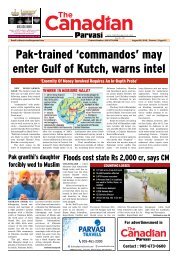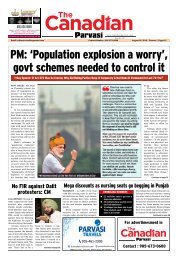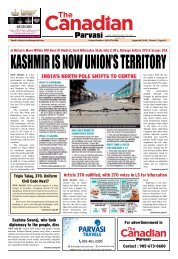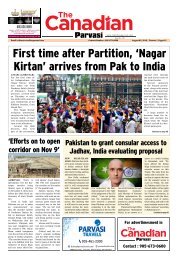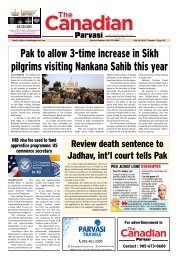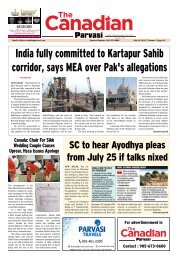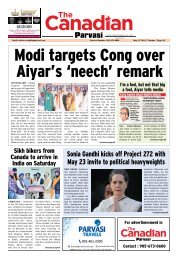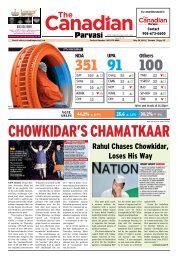The Canadian Parvasi - Issue 46
Create successful ePaper yourself
Turn your PDF publications into a flip-book with our unique Google optimized e-Paper software.
<strong>The</strong> International News Weekly india<br />
May 18, 2018 | Toronto 08<br />
Karnataka government: what happens next?<br />
Continued 10 page 01<br />
One of the possibilities is<br />
that the court would advance<br />
the date for a floor test and<br />
leave the party with the most<br />
number of members to form a<br />
government. <strong>The</strong> BJP has 104<br />
members while the Congress<br />
and the JD(S) jointly have 117<br />
members, which is well past<br />
the majority mark.<br />
If after the floor test, Mr.<br />
Yeddyurappa is unable to<br />
prove his majority, it would<br />
be incumbent on the part of<br />
the Governor to invite the<br />
combination of Congress and<br />
the JD(S) to form a government.<br />
Under the Sarkaria Commission<br />
report of 1988, if the<br />
single largest party fails, the<br />
next in the pecking order is a<br />
post poll alliance.<br />
This is the formula endorsed<br />
by the Supreme Court<br />
in several judgments.<br />
Besides, Mr. Singhvi<br />
has asked whether the Karnataka<br />
Governor had taken<br />
into consideration the fact<br />
that Sarkaria Commission<br />
required the largest single<br />
party to have the support of<br />
other parties, including “Independents”,<br />
in order for them<br />
to gain priority over a post<br />
poll alliance to form a government.<br />
After BJP's 'largest-party theory'<br />
in Karnataka, opposition to stake<br />
claim to govt in four other states<br />
NEW DELHI: A day after<br />
Karnataka governor Vajubhai<br />
Vala invited BJP, the<br />
single-largest party, to form<br />
a government in the state,<br />
Opposition parties are demanding<br />
that the governors<br />
of four other states — Goa,<br />
Bihar, Meghalaya and Manipur<br />
— should invite them<br />
to stake claim to the government<br />
as they were the singlelargest<br />
parties in last assembly<br />
polls held in these states.<br />
While the Congress announced<br />
it will be meeting<br />
Goa governor Mridula Sinha<br />
to ask him to invite the party<br />
to stake claim to the government,<br />
RJD leader Tejashwi<br />
Yadav also asked the Bihar<br />
governor Satya Pal Malik to<br />
dissolve the assembly and invite<br />
his party to form a government<br />
in the state.<br />
Later in the day, opposition<br />
parties in two more<br />
states stake claim to form the<br />
government. Former Manipur<br />
CM Okram Ibobi Singh<br />
and former Meghalaya CM<br />
Mukul Sangma sought time<br />
from respective governors<br />
of the state for a meeting tomorrow.<br />
In Goa's 2017 assembly<br />
election, Congress was the<br />
single-largest party with 21<br />
seats in the 40-seat assembly,<br />
however, it was the BJP<br />
through a post-poll alliance<br />
Highlights<br />
• <strong>The</strong> Congress announced that it will be meeting Goa<br />
governor to ask him to invite the party to stake claim<br />
to the govt<br />
• RJD leader Tejashwi Yadav, meanwhile, asked Bihar<br />
governor Satya Pal Malik to dissolve the assembly<br />
• <strong>The</strong> Karnataka governor had invited BJP, the singlelargest<br />
party, to form the government in the state<br />
that ended up forming the<br />
government, In Bihar, the<br />
RJD was the single-largest<br />
party with 80 seats in the 243-<br />
seat assembly in the 2015 assembly<br />
election, but it ended<br />
up in the opposition.<br />
In Manipur assembly<br />
elections, the Congress was<br />
three short of the majority<br />
mark with 28 seats in the 60-<br />
seat assembly.<br />
<strong>The</strong> saffron party, with<br />
21 seats, joined hands with<br />
National People's Party (four<br />
seats), Naga People's Front<br />
(four seats) and the Lok Janshakti<br />
Party (one seat) to<br />
form the first BJP government<br />
in the state.<br />
In Meghalaya, Congress<br />
was the largest party with 21<br />
seats, followed by National<br />
People's Party (NPP) with 19<br />
seats in the assembly polls<br />
held in 2017. NPP's Conrad<br />
Sangma formed the government<br />
with the support of 34<br />
MLAs.<br />
According to reports<br />
on ANI, Congress's Goa incharge<br />
Chella Kumar today<br />
said he along with more leaders<br />
will meet the governor of<br />
Goa and ask him to invite<br />
his party to form the government.<br />
<strong>The</strong> party is also planning<br />
to parade its 17 MLAs at<br />
the governor house, according<br />
to a source.<br />
Soon after, in an apparent<br />
show of unity against the<br />
events unfolding in Karnataka,<br />
RJD leader Tejashwi<br />
Yadav followed suit, asking<br />
governor Satya Pal Malik to<br />
dissolve the Bihar assembly<br />
and invite RJD on account<br />
of it being the single-largest<br />
party in the state.<br />
"We would be holding a<br />
one-day dharna tomorrow<br />
against the murder of democracy<br />
in Karnataka. We<br />
also request the Bihar governor<br />
to dissolve the state government<br />
and like in Karnataka<br />
invite the single largest<br />
party, which in Bihar is the<br />
RJD," said Tejashwi Yadav.<br />
Delhi will be world's<br />
biggest city by 2028: UN<br />
Continued from page 01<br />
He was speaking at the release of<br />
the revisions to the World Urbanisation<br />
Prospects 2018 report. It said that after<br />
surging past Tokyo in 2028, the population<br />
of Delhi urban agglomeration would<br />
grow to 39 million by 2030 from 29 million<br />
now. Tokyo's ageing population is projected<br />
to stay constant at the current level<br />
of 37 million, according to the data accompanying<br />
the report. "It is interesting<br />
to note that around the same time India<br />
is expected surpass China as the country<br />
with the world's total largest population,"<br />
Wilmoth said.<br />
According to an earlier UNDESA estimate,<br />
India's population is expected to<br />
reach 1.438 billion in 2024, exceeding China's<br />
1.436 billion. <strong>The</strong> urbanisation data<br />
projected that in 2030 the urban agglomeration<br />
of Mumbai will hold on to its rank<br />
as the sixth largest with a population of<br />
25 million, up from 19 million in 2015.<br />
Kolkata will move down in 2030 to the<br />
16th place from 13th in 2015, even though<br />
its population would increase from 14<br />
million to 18 million. Bengaluru, which<br />
ranked 29th in 2015, will move up to the<br />
21st spot as its population grows from 10<br />
million to 16 million. Other Indian cities<br />
do not figure in the list of the world's 30<br />
most populous cities.<br />
Shanghai will continue to be the<br />
world's third biggest urban area with a<br />
population of 33 million in 2030 and Dhaka<br />
will be fourth with a population of 28<br />
million, followed by Cairo with 26 million,<br />
according to the data.<br />
India's current rural population of 893<br />
million is the largest in the world and is<br />
59.1 per cent of India's total population of<br />
1.35 billion.<br />
<strong>The</strong> year 20<strong>46</strong> will mark an inflection<br />
point when more than half the Indian<br />
population will be urban. Its total population<br />
would cross 1.65 billion in 2045.<br />
"We have to see urbanisation as a<br />
positive thing," Wilmoth said outlining<br />
its benefits. It is easier to more efficiently<br />
and economically provide infrastructure<br />
and services like education and healthcare<br />
in urban settings where the population<br />
is concentrated compared to rural<br />
areas where it is scattered, he said.<br />
Urbanisation minismises environmental<br />
impact of humans by concentrating<br />
its impact in certain areas and allowing<br />
the preservation of land elsewhere,<br />
he added.<br />
But he said that rapid urbanisation<br />
has been occurring in developing countries<br />
which do not have the resources to<br />
deal with populations moving to cities resulting<br />
in slums and unplanned growth.<br />
To counter these trends there has to<br />
be better management and good planning<br />
for urban growth, he added.



